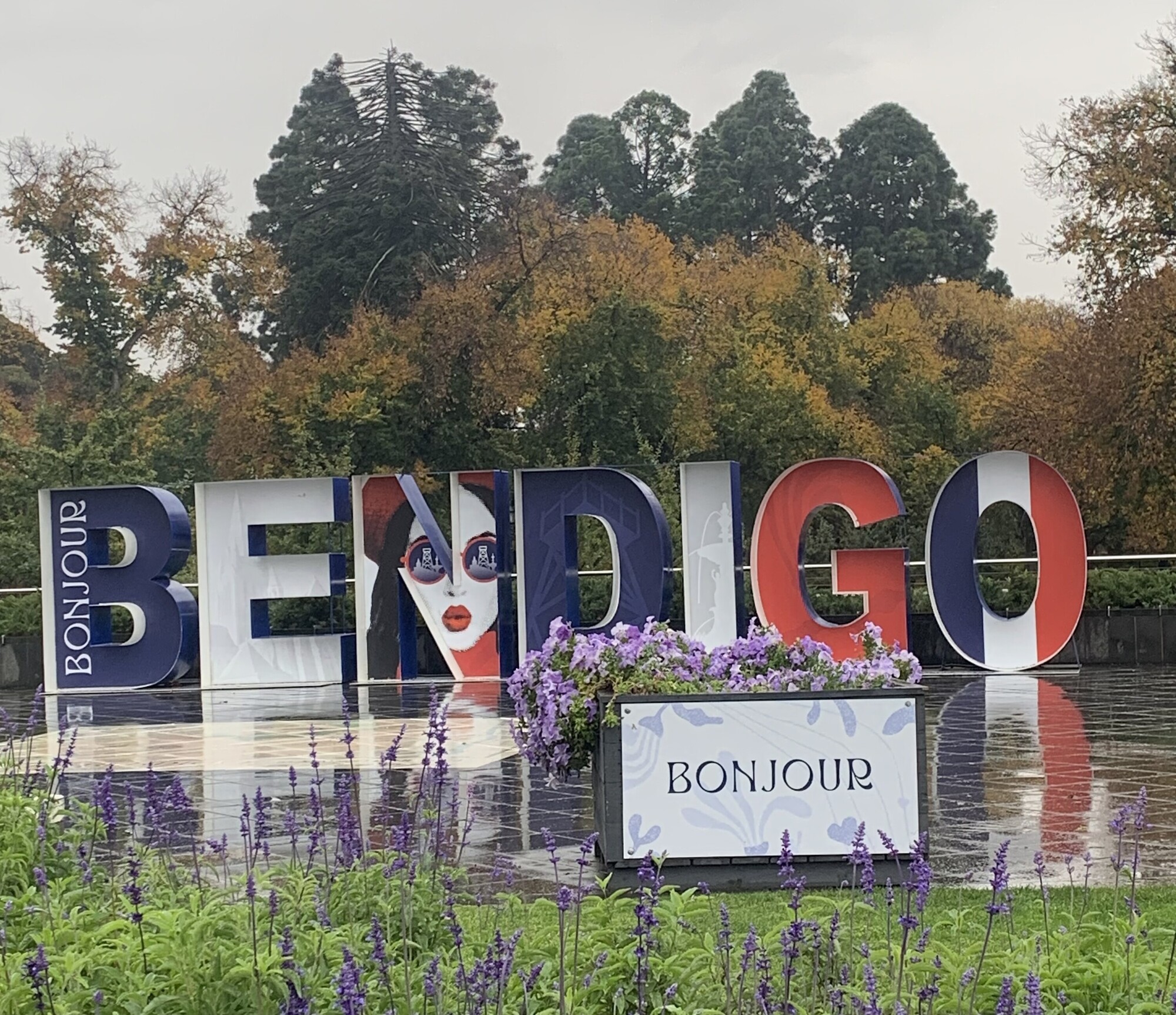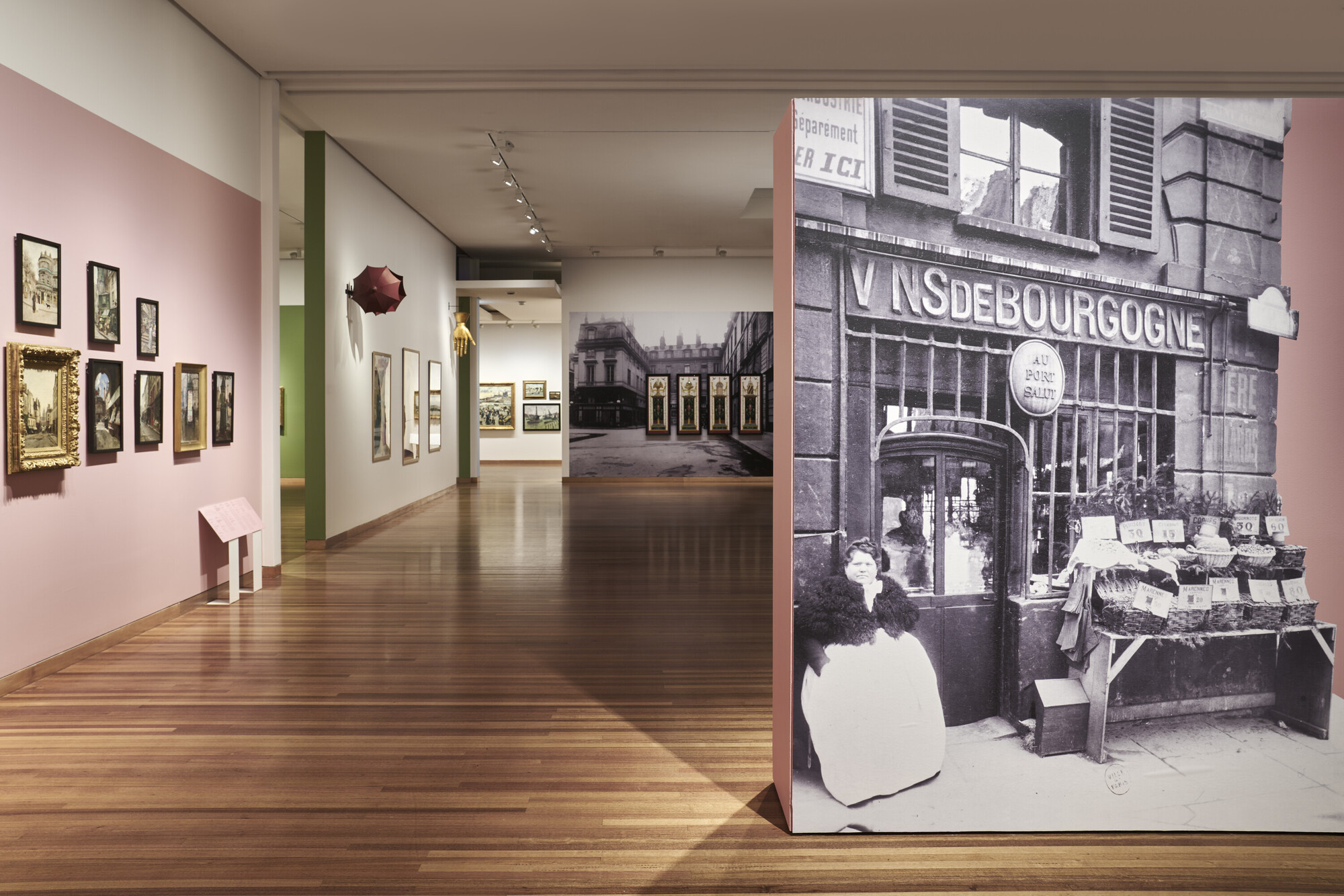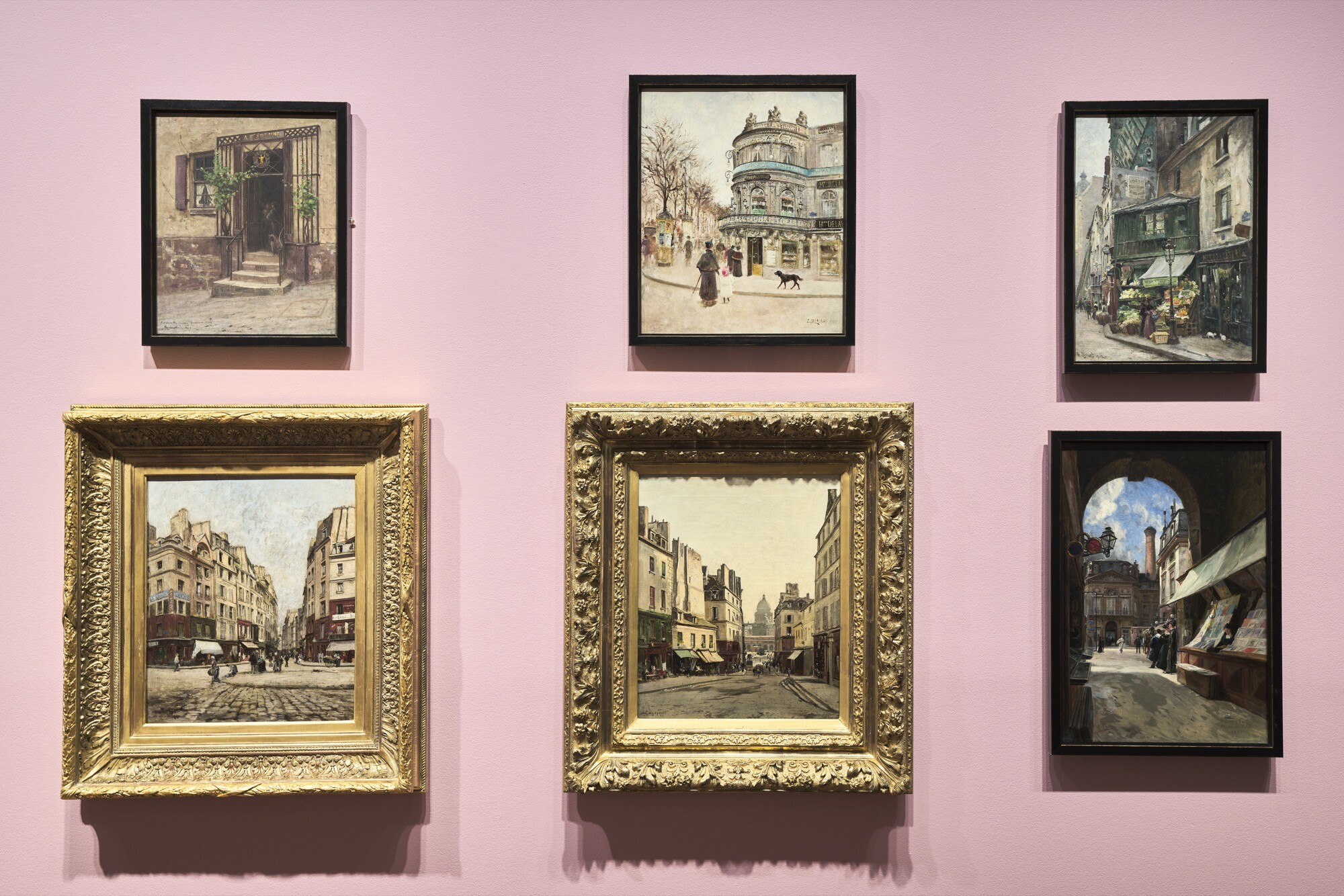Jean Béraud, Le boulevard Poissonière sous la pluie, Vers, 1880
Paris: Impressions of Life 1880–1925
Tara Heffernan
Impressionism … is another name for that final scepticism which can find no floor to the universe.
—G. K. Chesterton (1908).
Paris is not simply a geographical location but a set of signifiers and cultural referents. The city’s mythology as an unmatched symbol of cosmopolitanism, avant-gardism, luxury, and progress still persists today, looming largest in provincial minds. “It’s a kind of sickness,” to quote the disillusioned anti-hero of Wim Wenders’s Paris, Texas (1984). If you’ve visited the Greater City of Bendigo in the past months, you’ve likely noticed the phrase “Bonjour Bendigo!” plastered around the city. The colourful props and posters bearing the French greeting are part of a tourism campaign promising to bring “the city of love and light” to Bendigo. The centrepiece is Paris: Impressions of Life 1880–1925, a surprisingly compelling historic exhibition at Bendigo Art Gallery (BAG).
The exhibition’s title plays on the association with Impressionism, the highly influential avant-garde painting movement born in nineteenth-century France. However, the art displayed is mostly by minor artists. While the innovators of the avant-garde are housed in the bustling Louvre or Musée d’Orsay, BAG has primarily sourced its material for this exhibition from the Musée Carnavalet. The institution is not an art gallery, but a museum dedicated to the history of Paris. Accordingly, the “impression” Paris Impressions of Life cultivates is not anchored in the masterpieces of the decades of the late nineteenth and early twentieth centuries, but a constellation of cultural objects and artefacts mined from the mythologised era, from a time when Paris was globally recognised as a dynamic modern city.

Promotional signage for Bonjour Bendigo at Queens Garden, Pall Mall, Bendigo, May 2024.
The exhibition is arranged across seven themed spaces: Market Town Show, Parisian Public Gardens, The Seine, Universal Exhibitions and the Eiffel Tower, Bohemian Life in Montmartre, Musée Carnavalet, and The Champs-Élysées. Key events, places, and vistas are covered in these themed spaces, which were curated with the assistance of exhibition designers Anita Gigi and Cody Buchanan.
The first three spaces contain a wealth of paintings tightly arranged in salon-style hangs alongside ornate artisan shop signs, advertisements, archival footage, and photographs. Occasionally, the latter are reproduced on the gallery wall, scaled-up to life-like proportions, as in the figures of a vendor and client from Louis Vert’s photograph Ice-cream seller (1901–06). This is a concession to immersive exhibition design. Indeed, promotional material for the exhibition promises “a journey through the lively and picturesque streets of historic Paris” via “themed pathways.”
One of the most prominent artists featured is Jean Béraud (1849–1935). As French novelist and art critic Joris-Karl Huysmans summarised, Béraud “confined himself to painting what he’d experienced.” His Le boulevard Poissonnière sous la pluie (1880), featuring in the first themed section of the exhibition, is no exception. Here, he depicts a crowded boulevard in the rain—a quintessential Parian Street scene. There is little rhythm to this crowd. These subjects appear largely unaware of each other as they scatter on the rain-soaked street. It’s a strikingly modern painting that calls to mind another French artist’s work (not exhibited), the social realist Gustave Courbet’s provincial funeral Un enterrement à Ornans (1849–50).

Installation view of Market Town Show, themed room in Paris: Impressions of Life 1880–1925, Bendigo Art Gallery. Image courtesy of Bendigo Art Gallery. Photo: Leon Schoots

Installation view, Paris: Impressions of Life 1880–1925. Image courtesy of Bendigo Art Gallery. Photo: Leon Schoots
Despite the grandeur implied by gilded frames, the distinction between the paintings, photographs, and artifacts featured isn’t at all jarring. In fact, there is an aesthetic coherence, as though they are all similar kinds of artifacts. No hierarchy is imposed by the aura of art.
Aside from Paul Signac, the big names of the Impressionist movement are mostly absent from Paris Impressions of Life. There’s no Pissarro, no Manet, no Degas! Due to the avant-garde mythologisation and bourgeois assimilation of the style, it’s easy to forget that the Impressionists were initially regarded as mentally defective and degenerate. Bolstered by their icon status and virally spread by the technologies of mass reproduction, canonised work has been travelling through time, becoming somewhat timeless. In a sense, the triumphant transgressors of tradition have been robbed of their era-specificity.
Moreover, conservative critics continue to distrust the unboundedness of Impressionism, the desire to convey a feeling—and to prioritise that internal truth over accurate representation. This, in turn, also untethers the image from the context of time, place, and artistic convention. By contrast, the more conservative paintings that populate Paris: Impressions of Life couldn’t be more bound to their context. Rigid, academic, and lacking the emotional liveliness and evocative quality we associate with Impressionism, these works boast what the canonised figures eschewed: accurate social documentation. Paintings like Paul Schaan’s Le passage Vérité et la place de Valois (1897) or Henri Vignet’s Rue Galande (1902) depict in detail the geometries of Parisian shopfronts crammed into narrow streets. Though the feathery blur of the Impressionistic brushstroke graces these canvases, the fidelity to the real retains the scenes’ structural integrity. Theirs is an Impressionism that errs toward realism, like a filter added post-production.
Ironically, these academic canvases offer a more defined “impression” of Paris life than those of leading avant-garde figures. As a floating signifier, Impressionism is almost a byword for “art,” and this prestige provides great rhetorical garnish in the exhibition title. As Joseph Pearce summarises, today Impressionism is “almost twee … the sort of art one expects to see on a chocolate box or adorning the most inoffensive of calendars … too safe and acceptable to be seen as revolutionary.” But regardless, the conventional paintings populating the exhibition still have the capacity to appease a non-artistic mind—as they likely always will—with their spectacle of skill, rich glossy palette and theatrical scenes. A cautious respect for the tether between abstraction and figuration must be exercised to satiate bourgeois taste.

Installation view The Universal Exhibition and the Eiffel Tower, themed room in Paris: Impressions of Life 1880–1925. Image courtesy Bendigo Art Gallery. Photo: Leon Schoots
Huysmans concluded his sprawling review of the Paris Salon 1880 by advising his readers “to refresh their eyes outside.” In particular, he championed Jules Chéret, an illustrator whose work features in Paris: Impressions of Life. “There’s a thousand times more talent in the least of these posters,” he claimed, than the majority of work bolstered by the established tastemakers of the Salon. For example, Chéret’s Poster for the Palais de Glace (1896) features two dancing figures: a moustachioed, feline-featured man and a grinning woman swathed in patterned fabric, with a rose-like head of ribbons and feathers. These saccharin puppets, erring on the grotesque, possessed for Huysmans an energy more akin to that of modern life.
The exhibition begins to wane somewhat in the rather slender room dedicated to The Universal Exhibition and the Eiffel Tower. Featured paintings include Adolphe Gumery’s The Eiffel Tower seen from the garden Delessete (1903), displaying the base of the tower emerging from bulbous trees, and Louis Bumoulin’s Point du Jour, Quai d’Auteuil (1890), an empty café scene with the tower peeking in from the background. These paintings, and the few artefacts displayed, are trumped by a giant photograph of the Eiffel Tower (sourced from the Library of Congress, United States) affixed to the back wall. Perhaps it’s difficult to get away with just an impression of such a structure of modernity. Artistic innovation, it seems, can’t compete—or contend with—a masterpiece of modern engineering.
The exhibition’s informational emphasis and historical narrative adheres to the conventions of edu-tainment. Thankfully, however, the exhibition design is mostly unimposing. One subtle feature is sound. Piped in from speakers in the ceiling, music, or soundscapes respond to the themed spaces. In The Market Show, street sounds accompany archival footage of the Flower market at Les Halles (1913) from the GP Archives, Paris. Small considerations like this, along with the detritus of life collected in display cases—clothing, menus, posters, a Bar spinner from the Bal Tabarin cabaret—all contribute to an impression of life in the period. This impression is fleeting and incomplete, not due to an “Impressionistic” lightness of hand, but the inability to convey the reality of history, which is always partial and imbued with the values and ideological concerns of the era in which it is retold. However, history, when conveyed well, can spark something in us. It’s similar to the feeling we get when we read convincing literature. The realisation that “these are people like me,” though we might be separated by great distances, even centuries. This runs counter to the false but widely accepted belief (rife in contemporary art) that the museum or gallery offers nothing when it just contains “stuff”, not relational, community-based artworks, or interactive games scaffolded with therapeutic clichés, exercises that betray the impulse to strip art of its regard for inner life and our imaginative capacities.
Part of the acceleration of life in the nineteenth century was tied to the encroachment of a documentary society. Indeed, impressions of life are also biopolitical. Each room has a map of Paris affixed to the wall highlighting the location from which the featured artworks and artefacts originate from or commemorate. It’s both a gimmicky wayfinder and a useful historical story-telling tool, nailing the displayed objects to a time and a place rather than letting them float free of context, as artworks in galleries often do.
The map is also a kind of impression. Though an abstraction of information, it adheres rather rigidly to a set of rules dictating its representational grammar. As Michel Houellebecq summarises, in the map we find “the essence of modernity, of scientific and technical apprehension of the world … combined with the essence of animal life.” Houellebecq describes the map’s seduction as inextricably linked with its simplicity: the conveyance of complex visual information in a simple palette and clear lines. He continues “in each of the hamlets and villages, represented according to their importance, you felt the thrill, the appeal, of human lives, of dozens and hundreds of souls—some destined for damnation, others for eternal life.” Maps also dictate value and direct commercial engagement. Indeed, Michelin Maps were created by a tyre company to guide motorists’ journeys and boost tyre sales in turn. Later, they began a star system to recommend restaurants around the provinces. Bonjour Bendigo similarly drives revenue, drawing people to the city’s businesses with cosmopolitan promises and accommodation packages such as the “Glamtainer Glamour” experience in Castlemaine.

Jean Béraud, Dîner aux Ambassadeurs, c. 1880, oil on canvas, 37.5 x 45 cm. Image courtesy Bendigo Art Gallery.
The fantasy of Paris, dislocated from its geography or otherwise hybridised, is a recurring trope in art and culture. Australia has a few examples beyond Paris, Bendigo. The artist-run initiative Disneyland Paris takes its name from the theme park, a testament itself to the spread of American commercialism. It is “a ridiculous name” for an artist run space, as art historian Darren Jorgensen has levelled, though this ludicrousness is no doubt intentional. There’s also The Paris End, a Substack run by three Melbourne writers borrowing its name from the so-called “Paris end” of Melbourne’s Collins Street, a strip of high-end boutiques, heritage buildings and cafés. Though its content rarely addresses anything occurring in the locality, its reportage is furnished by the mannerisms and affectations of those who hold cosmopolitan ideals and a quasi-anthropological curiosity regarding ordinary people outside their inner-city circles, their strange customs and provincial ways. In both cases, Paris is referenced not simply as a genuine beacon of cosmopolitanism, but as a thoroughly debased symbol that nonetheless persists, though with particular fervour for an unworldly, philistine subject.
While French cosmopolitan artists were experimenting with airy brushstrokes and bright palettes, Bendigo was transformed from a dusty mining community, sparsely dotted with modest cottages, to a city with international reach. During the “Bendigo Boom” of 1870–1901, mining magnates flaunted their wealth with grand, opulently decorated buildings. Among the medley of European influence, distinctly French influences are observable in the French–Renaissance inspired Bendigo Post Office (now the Visitor’s Centre), and Second Empire style of the Law Courts, Military Museum and other buildings along Bendigo’s central thoroughfare, Pall Mall. Mining money brought Europe to Australia and, although the glamour has faded, the architecture remains. A rainy winter day in Bendigo does resemble a Béraud canvas, but only from afar.
The fantasy of Paris is compelling for its pervasiveness. When Japanese tourists travel to Paris, they regularly succumb to “Paris syndrome.” Delusions, an accelerated heart-rate, dizziness, anxiety, and paranoid thinking are all symptoms. The condition is brought on by a crushing reality check: Paris doesn’t match their idealised vision. Indeed, “the encounter with the real is always traumatic,” as Slavoj Žižek reminds us, “there is something at least minimally obscene about it; I cannot simply integrate it into my universe, there is always a gulf separating me from it.” We can enjoy the idea of Paris—a fantasy furnished by imported or stylised objects, artefacts, and accoutrements—but the pleasure is partly predicated on this very separation. The objects of our fantasies look best from a safe distance, behind the veil of unsatisfied desires and the covert pleasures of mystery.
Still, we’ll always have Paris, Bendigo.
Tara Heffernan is an art historian and critic.